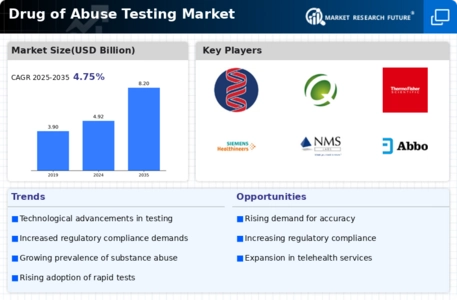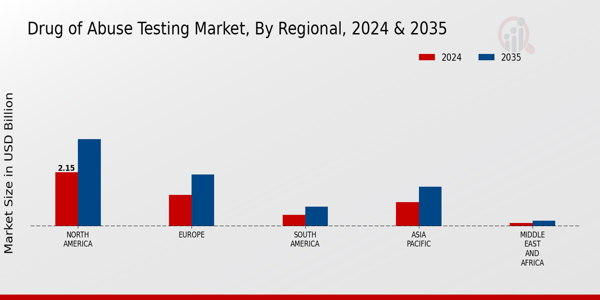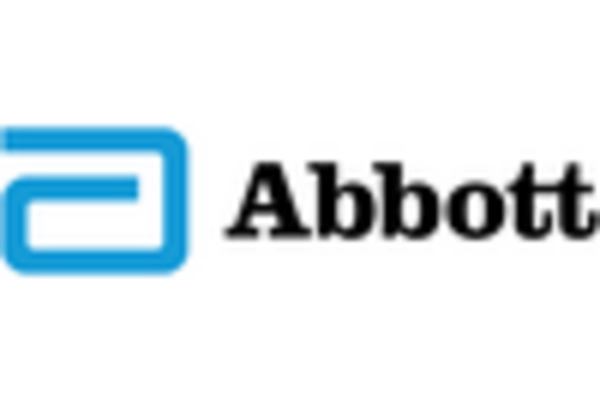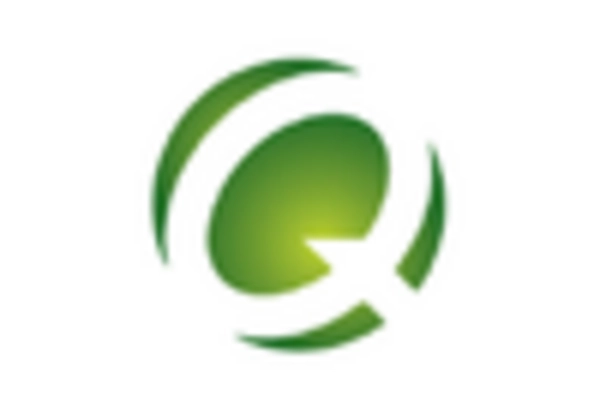Increasing Substance Abuse Rates
The rising rates of substance abuse across various demographics appear to be a primary driver for the Drug of Abuse Testing Market. Reports indicate that the prevalence of drug use has escalated, particularly among young adults and adolescents. This trend necessitates more comprehensive testing solutions to address the growing concern of addiction and its societal impacts. As a result, healthcare providers, employers, and educational institutions are increasingly investing in drug testing programs to ensure safety and compliance. The market is projected to witness substantial growth, with estimates suggesting a compound annual growth rate of over 7% in the coming years, driven by the urgent need for effective drug monitoring and prevention strategies.
Regulatory Compliance and Workplace Safety
Regulatory compliance remains a crucial factor influencing the Drug of Abuse Testing Market. Governments and regulatory bodies have established stringent guidelines for drug testing in various sectors, particularly in transportation, healthcare, and manufacturing. These regulations mandate regular testing to ensure workplace safety and reduce liability risks. Organizations are compelled to implement drug testing protocols to comply with these regulations, thereby driving demand for testing services and products. The market is likely to expand as companies seek to mitigate risks associated with substance abuse among employees, with a notable increase in the adoption of rapid testing methods that provide immediate results.
Rising Awareness of Drug Abuse Consequences
The increasing awareness of the consequences of drug abuse is driving the Drug of Abuse Testing Market. Educational campaigns and public health initiatives are effectively informing communities about the dangers of substance misuse. This heightened awareness is prompting individuals and organizations to prioritize drug testing as a preventive measure. Schools, workplaces, and rehabilitation centers are increasingly implementing drug testing programs to identify and address substance abuse issues early. The market is expected to grow as more stakeholders recognize the importance of proactive measures in combating drug-related problems, leading to a surge in demand for testing services.
Technological Innovations in Testing Solutions
Technological advancements in testing methodologies are reshaping the Drug of Abuse Testing Market. Innovations such as point-of-care testing, mobile testing units, and advanced analytical techniques are enhancing the accuracy and efficiency of drug testing. These technologies not only reduce the time required for results but also improve the overall user experience. The integration of artificial intelligence and machine learning in data analysis is further streamlining testing processes. As these technologies become more accessible, organizations are likely to adopt them, leading to a more robust market. The introduction of non-invasive testing methods, such as saliva and sweat tests, is also expected to contribute to market growth.
Expansion of Drug Testing in Healthcare Settings
The expansion of drug testing in healthcare settings is a notable driver for the Drug of Abuse Testing Market. Healthcare providers are increasingly recognizing the importance of drug testing in managing patient care, particularly in pain management and addiction treatment. The integration of drug testing into routine medical assessments allows for better monitoring of patient compliance and the identification of potential substance abuse issues. As healthcare systems evolve, the demand for comprehensive drug testing solutions is likely to rise. This trend is expected to contribute to market growth, as healthcare facilities seek to enhance patient safety and treatment outcomes through effective drug monitoring.


















Leave a Comment